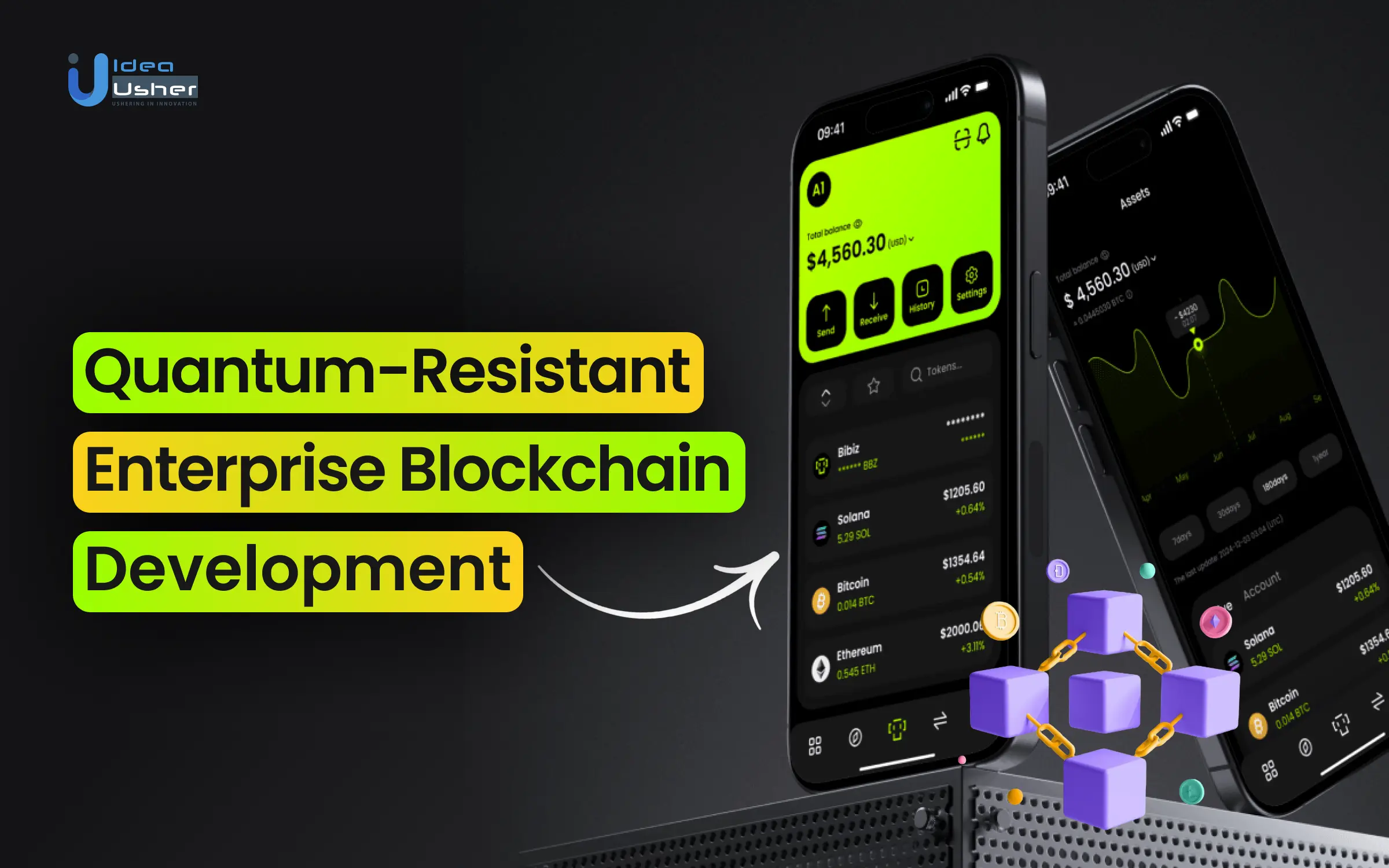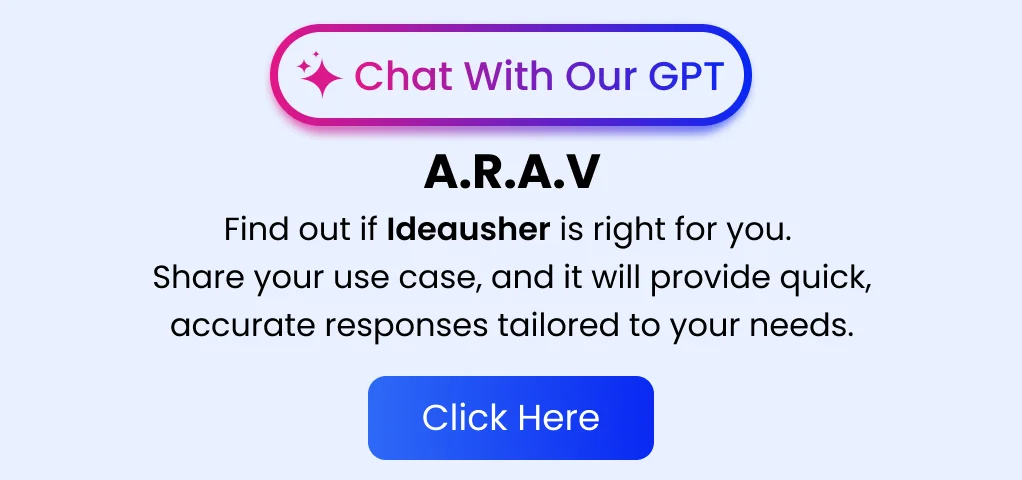Blockchain technology is changing the way industries operate, but the rise of quantum computing could soon threaten its security. Traditional cryptography methods, like RSA and ECC, which protect blockchain transactions today, may not hold up against the power of quantum computers. With experts predicting that quantum technology could break these systems in the near future, businesses must start planning for quantum-resistant solutions. According to PwC, the blockchain market is expected to hit $23.3 billion by 2023, making the need for quantum-secure blockchains more urgent than ever.
A great example of a quantum-resistant blockchain is Quantum Resistant Ledger. QRL uses XMSS, a cryptographic algorithm designed to be secure against both classical and quantum computing threats.
Building a quantum-resistant enterprise blockchain means using advanced cryptographic protocols while preserving key blockchain features like decentralization and transparency. It involves choosing secure post-quantum algorithms, such as lattice-based or hash-based systems, to protect digital transactions.
As more businesses adopt blockchain for things like supply chain tracking and financial services, ensuring quantum resistance will be crucial to protect against future cyber threats.
Overview of Quantum-Resistant Blockchains
A quantum-resistant blockchain is a type of blockchain built to protect against the future risks posed by quantum computing. As quantum computers advance, they could potentially break the current cryptographic methods used in traditional blockchains, such as RSA and Elliptic Curve Cryptography. These methods rely on mathematical problems that are hard for regular computers to solve, but quantum computers could solve them easily using algorithms like Shor’s algorithm. Quantum-resistant blockchains are designed to stay secure even as quantum technology evolves.
Key Market Takeaways for Blockchains
According to GrandViewResearch, the blockchain technology market has seen remarkable growth, valued at USD 17.46 billion in 2023, and is expected to grow at a rapid pace of 87.7% annually through 2030. However, with the increasing adoption of blockchain platforms, there has also been a rise in cyber threats.
Source: GrandViewResearch
One of the key factors driving this surge is the need for stronger encryption as quantum computing advances. Traditional encryption methods like RSA and ECC, which have long been trusted for securing data, are becoming vulnerable to quantum-powered attacks. This has led industries across finance, healthcare, and government to invest in quantum-resistant technologies to protect sensitive data and meet tighter security regulations.
Some pioneering blockchain projects are taking the lead in addressing these concerns. For example, the Quantum Resistant Ledger, launched in 2018, uses the XMSS, a special type of digital signature designed to withstand quantum threats.
Additionally, many projects are exploring hybrid cryptographic systems that combine traditional encryption with quantum-resistant algorithms. This approach ensures a smooth transition to quantum-secure systems while preserving existing infrastructure.
As blockchain continues to become a crucial part of various sectors, the development of quantum-resistant technologies will be key to its secure and sustainable future.
Work with Ex-MAANG developers to build next-gen apps schedule your consultation now
Why do Businesses Need a Quantum Resistant Blockchain?
As blockchain technology becomes more central to business operations, the rise of quantum computing raises concerns about the security of current cryptographic methods. Traditional algorithms like RSA and ECC, which many blockchain platforms rely on, could be cracked by future quantum computers. By adopting quantum-resistant blockchain solutions now, businesses can future-proof their networks, ensuring their data and transactions remain secure in the face of emerging quantum threats.
Projects like QANplatform are already leading the charge with hybrid private blockchains that integrate post-quantum algorithms, such as CRYSTALS-Dilithium, recognized by NIST. With impressive speeds—up to 1,600 transactions per second —QANplatform is 100 times faster than Ethereum and can handle up to 97,000 TPS for enterprise-level applications. This makes it a powerful choice for businesses that need both security and scalability.
Similarly, DAMS, backed by the Japan Exchange Group, has developed Digital Shelter, a quantum-resistant platform that uses post-quantum cryptography to protect sensitive data.
With projects like QANplatform securing multi-million dollar investments and platforms like DAMS pushing forward real-time settlement systems, it’s clear that adopting quantum-safe blockchain technology is a strategic move for businesses aiming to stay ahead of the curve in this rapidly evolving digital world.
How Does Quantum-Resistant Blockchains Work?
Quantum-resistant blockchains are being created to protect networks from the risks of quantum computing. As quantum computers improve, they could break the encryption that keeps blockchain secure. To stay ahead, these blockchains use advanced cryptographic methods designed to stay safe even in a quantum-powered world.
1. Post-Quantum Cryptography
Quantum-resistant blockchains rely on cryptographic algorithms that are believed to be secure against both traditional and quantum attacks. These include:
- Lattice-Based Cryptography: This method depends on the difficulty of lattice problems, which quantum computers find hard to solve.
- Hash-Based Cryptography: Hash functions are used to create digital signatures that quantum computers cannot easily break.
- Multivariate Polynomial Cryptography: Built around solving complex multivariate polynomial equations, which are also challenging for quantum systems to decipher.
2. Quantum-Resistant Digital Signatures
Traditional digital signature methods like RSA and ECC would be vulnerable to quantum threats. Quantum-resistant signatures employ systems like the eXtended Merkle Signature Scheme and SPHINCS+, which are specifically designed to be immune to quantum attacks.
3. Quantum-Resistant Key Exchange Protocols
These protocols help secure the process of sharing encryption keys between users. By using quantum-resistant techniques, they prevent quantum computers from intercepting or breaking the keys, ensuring that communications over the blockchain remain private and intact.
4. Quantum-Resistant Consensus Mechanisms
Some quantum-resistant blockchains use consensus mechanisms that can withstand quantum-based threats. For example, Quantum Proof-of-Work (PoW) combines traditional PoW with quantum-safe cryptographic methods, ensuring that transaction verification stays secure even in a quantum future.
5. Implementing Quantum Resistance
To make existing blockchain networks resistant to quantum threats, several approaches can be taken:
- Hybrid Cryptographic Schemes: These combine traditional cryptographic algorithms with post-quantum ones. This allows blockchain systems to gradually transition to quantum resistance without disrupting their current operations.
- End-to-End Frameworks: Some solutions propose frameworks that can be integrated into existing blockchain networks. These frameworks enable blockchains to achieve quantum resistance without needing a complete overhaul.
Development Steps for a Quantum-Resistant Enterprise Blockchain
Here are some of the steps to develop a quantum-resistant enterprise blockchain,
1. Define Objectives and Use Cases
The development process begins with identifying the specific objectives and use cases for the quantum-resistant blockchain. Businesses must outline their goals, such as securing financial transactions, safeguarding sensitive data, or enabling private communication.
2. Choose a Post-Quantum Cryptographic Framework
Selecting the right cryptographic algorithms is critical. Lattice-based, hash-based, multivariate polynomial and code-based cryptography are popular choices for creating quantum-resistant blockchains. Each algorithm should align with the system’s intended security requirements and performance expectations.
3. Design the Blockchain Architecture
A robust architecture must be developed to incorporate post-quantum cryptographic algorithms. This includes defining the structure of the blockchain, consensus mechanisms, and transaction validation methods. Hybrid models combining classical and post-quantum cryptography can offer a transitional approach.
4. Integrate Post-Quantum Algorithms
Integrate the selected cryptographic algorithms into the blockchain’s core functionalities. These include securing transactions, generating digital signatures, and encrypting communication channels. Implementing algorithms like CRYSTALS-Dilithium or XMSS ensures compatibility and security.
5. Develop and Test Smart Contract Support
Smart contract functionality must be adapted to support post-quantum cryptographic operations. Comprehensive testing ensures that smart contracts perform efficiently while maintaining security in quantum-resistant environments.
6. Implement Secure Consensus Mechanisms
Consensus mechanisms like PoS or DPoS can be enhanced with quantum-resistant cryptographic techniques. The consensus algorithm must ensure that network integrity is not compromised, even in the presence of quantum-capable adversaries.
7. Optimize for Scalability and Performance
To ensure the blockchain is enterprise-ready, scalability and performance optimization are essential. This includes addressing transaction throughput, latency, and storage efficiency while maintaining the added computational load of quantum-resistant algorithms.
8. Conduct Rigorous Testing and Auditing
Rigorous testing is crucial to identify vulnerabilities in the system. Security audits should focus on the integration of post-quantum cryptography, ensuring resilience against both classical and quantum attacks.
9. Deploy and Maintain the Blockchain
Deploy the blockchain in a controlled environment, allowing businesses to validate its performance and security. Post-deployment maintenance involves regular updates to the cryptographic algorithms and system architecture to address evolving quantum threats.
Cost of Developing a Quantum-Resistant Enterprise Blockchain
| Development Stage | Description | Estimated Cost Range |
| 1. Research & Development | – PQC Algorithm Selection & Implementation:Involves selecting and implementing post-quantum cryptography (PQC) algorithms.- Consulting Fees: Engaging cryptography experts.- Performance Benchmarking: Ensuring algorithms meet enterprise performance requirements. | $5,000 – $15,000 |
| 2. Blockchain Development | Frontend Development:– Creating dashboards to monitor transactions and manage accounts.- Developing web and mobile apps for user interaction.Backend Development:– Building core blockchain infrastructure with PQC-compatible consensus mechanisms.- Smart contract and API development. | $15,000 – $50,000 |
| 3. App Features | – Tokenization: Issuing and managing digital assets.- Identity Management: Managing digital identities securely.- IoT Integration: Adding IoT connectivity to enable secure communication. | $10,000 – $20,000 |
| 4. Testing & Auditing | – Unit Testing: Verifying individual components.- Integration Testing: Ensuring smooth interaction between components.- Security Audits: Conducting external security checks.- Performance Testing: Checking scalability and transaction throughput. | $5,000 – $10,000 |
| 5. UI/UX Design | – User Research & Wireframing: Understanding user needs and creating initial designs.- Visual Design: Establishing branding and aesthetics.- Usability Testing: Collecting feedback and refining designs. | $5,000 – $15,000 |
Total Estimated Cost – $10,000 – $100,000
Factors Affecting the Development Cost of a Quantum-Resistant Enterprise Blockchain
Several factors can significantly impact the overall development cost of a quantum-resistant enterprise blockchain.
- Project Scope and Complexity: The number of features, integrations, and the overall complexity of the blockchain application directly impact development time and cost.
- PQC Algorithm Selection and Implementation: The choice of PQC algorithms (e.g., lattice-based, code-based) and their efficient implementation can vary greatly in cost and complexity.
- Research and Development: Continuous research is needed to stay abreast of the evolving PQC landscape, including algorithm improvements and standardization efforts.
- Security Audits: Specialized security audits are required to assess the vulnerability of the blockchain to quantum attacks and ensure the chosen PQC algorithms provide adequate security.
Top 5 Quantum-Resistant Blockchain Platforms
As quantum computing poses a growing threat to traditional cryptography, several blockchain platforms are emerging with quantum-resistant features. These platforms are designed to protect against future quantum attacks using advanced cryptographic techniques. Here are five of the most notable quantum-resistant blockchain platforms:
1. QANplatform
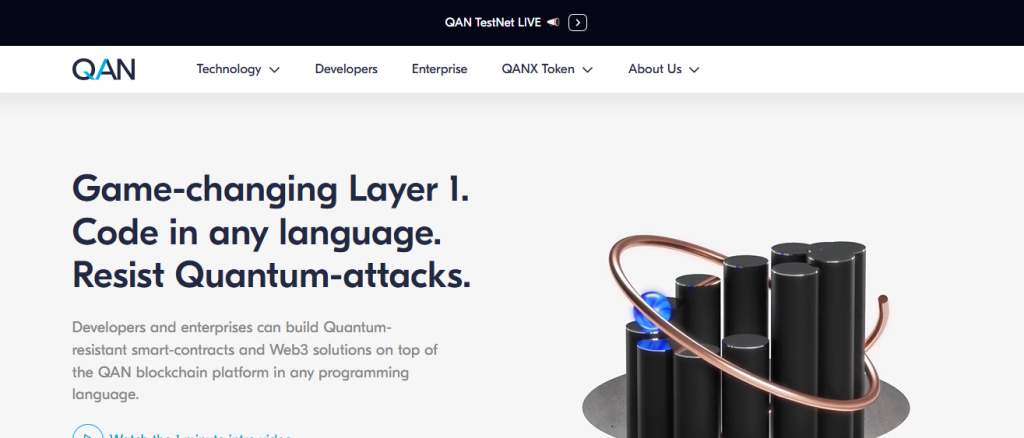
The QANplatform is a leading quantum-resistant blockchain that uses a lattice-based cryptographic algorithm to protect against quantum threats while still being compatible with current systems.
- It uses the CRYSTALS-Dilithium algorithm for quantum-resistant signatures, as recommended by NIST.
- Supports the Go programming language, making integration and development easy.
- Offers a hybrid approach that gradually integrates quantum-resistant algorithms alongside traditional ones.
2. Quantum Resistant Ledger
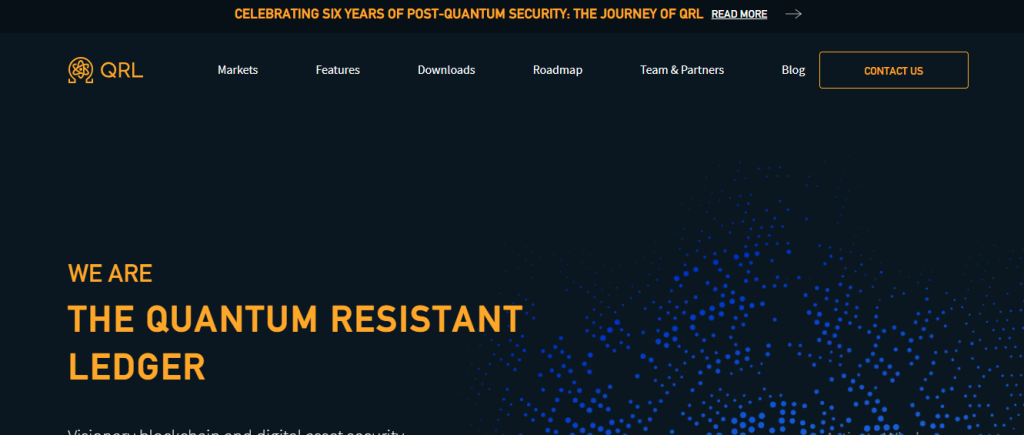
Launched in 2018, QRL was one of the first blockchains built to resist quantum attacks. It uses the eXtended Merkle Signature Scheme, a hash-based digital signature that provides strong security against quantum threats.
- Uses non-Elliptic curve encryption, which is more secure against quantum decryption methods.
- It focuses on forwarding security and enabling reusable addresses without compromising security.
- Built with minimal security assumptions, it strengthens its defense against future threats.
3. Nervos Network
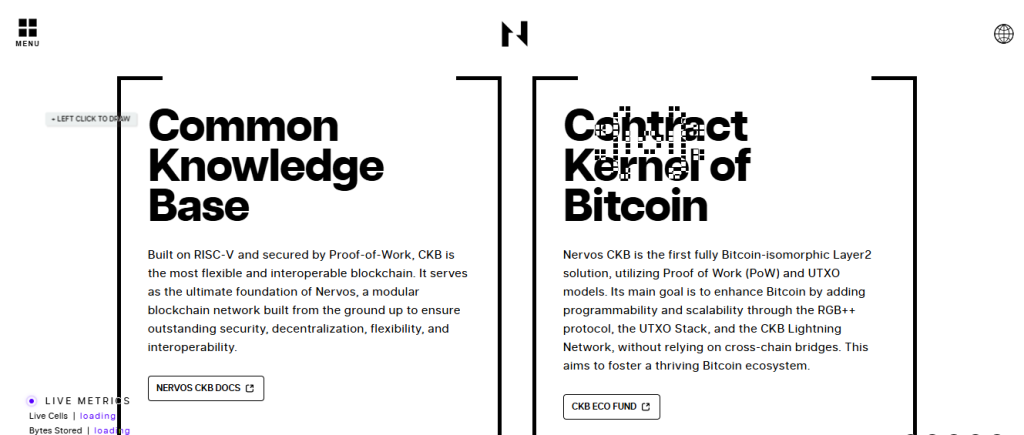
Nervos Network is a multi-layer blockchain ecosystem that integrates post-quantum cryptographic techniques to improve its security. It’s designed to offer a scalable and secure environment for decentralized applications.
- Combines classical and post-quantum algorithms in a hybrid cryptographic scheme.
- Focuses on a layered architecture, allowing flexibility to add new technologies and cryptographic methods as needed.
- Designed to gradually transition toward fully quantum-resistant solutions, making it adaptable to evolving threats.
4. IOTA

IOTA is best known for its focus on the Internet of Things (IoT), but it’s also taking steps to secure itself against quantum computing risks. Its unique consensus mechanism doesn’t rely on traditional mining, which adds to its flexibility.
- Plans to incorporate quantum-resistant cryptography, such as hash-based signatures.
- Uses Tangle technology, which allows secure transactions without blocks, potentially enhancing its resilience against quantum attacks.
- Actively researching and developing protocols for long-term security in a post-quantum world.
5. Algorand

Algorand is a high-performance blockchain focused on fast, secure transactions. It also researches ways to prepare for quantum threats with innovative cryptographic solutions.
- Exploring lattice-based and hash-based cryptography for quantum resistance.
- Its efficient consensus mechanism is scalable, making it well-suited for implementing advanced cryptography without losing performance.
- Collaborates with academic institutions working on post-quantum research to ensure long-term security.
Conclusion
Developing a quantum-resistant enterprise blockchain offers significant long-term advantages for businesses. By proactively addressing the emerging threat of quantum computing, we can safeguard sensitive data, maintain trust with customers and partners, and future-proof our operations.
This approach not only ensures security but also enhances market competitiveness and strengthens brand reputation. Moreover, it opens up new revenue streams through the development of innovative quantum-resistant blockchain solutions for various industries, such as supply chain management, finance, and healthcare. Ultimately, it’s about staying ahead of the curve and preparing for a rapidly evolving digital landscape.
Looking to Develop a Quantum Resistant Blockchain?
At Idea Usher, we bring over 500,000 hours of hands-on coding experience in blockchain technology, focusing on creating advanced, quantum-resistant solutions for businesses. Our team uses the latest cryptographic innovations, including post-quantum algorithms and QKD, to build secure blockchains that will stand strong against future quantum threats. By partnering with us, you’re not just staying ahead of the curve – you’re future-proofing your business with cutting-edge technology that safeguards your sensitive data. Let us help you stay secure, resilient, and ahead of the competition with a blockchain that’s ready for tomorrow’s challenges!
Work with Ex-MAANG developers to build next-gen apps schedule your consultation now
FAQs
Q1: How to develop a quantum-resistant blockchain?
A1: Developing a quantum-resistant blockchain requires integrating cryptographic algorithms that are secure against quantum computing threats, such as lattice-based, hash-based, or code-based cryptography. Traditional encryption methods like RSA and ECC are vulnerable to quantum algorithms like Shor’s algorithm. A quantum-resistant blockchain needs to adopt these new cryptographic techniques, and the protocol should be designed to ensure scalability, security, and decentralization while maintaining resistance to quantum-powered attacks.
Q2: How does a quantum-resistant blockchain work?
A2: A quantum-resistant blockchain works by implementing quantum-safe cryptographic algorithms that are difficult for quantum computers to break. These algorithms, such as post-quantum cryptography schemes, focus on mathematical problems that quantum computers cannot solve efficiently, such as lattice problems or multivariate quadratic equations. Transactions and block verifications rely on these quantum-resistant cryptographic primitives to ensure data integrity, authentication, and secure consensus, even in a world with quantum computing threats.
Q3: What are the features of a quantum-resistant blockchain?
A3: The key features of a quantum-resistant blockchain include quantum-safe cryptography, secure key management, and resistance to both classical and quantum computing attacks. It also focuses on backward compatibility to transition from current cryptographic methods to quantum-safe alternatives, high scalability, and robust privacy features. Additionally, such blockchains often use algorithms designed to be more resistant to quantum parallelization, ensuring long-term security even as quantum technologies advance.
Q4: What is the cost of developing a quantum blockchain?
A4: The cost of developing a quantum-resistant blockchain can be high, ranging from tens of thousands to millions of dollars, depending on the complexity and scope of the project. This includes research and development of quantum-safe cryptographic algorithms, updating or replacing existing infrastructure, hiring experts in post-quantum cryptography, and extensive testing to ensure the blockchain is secure and efficient.
